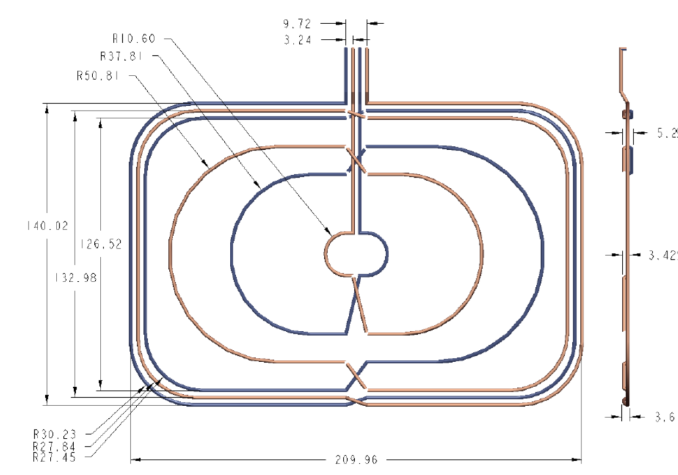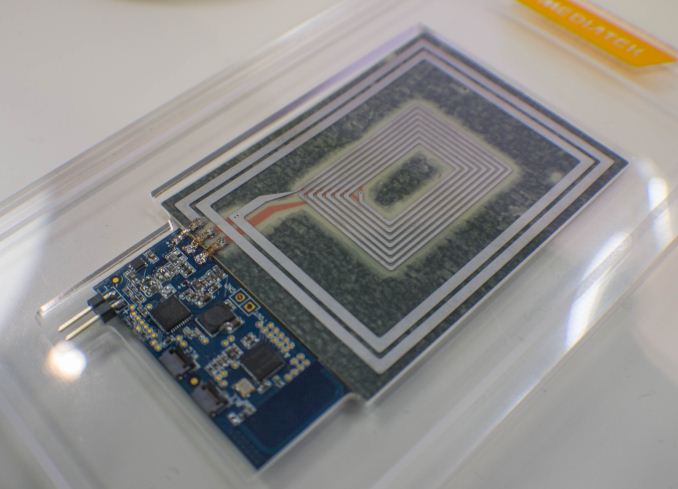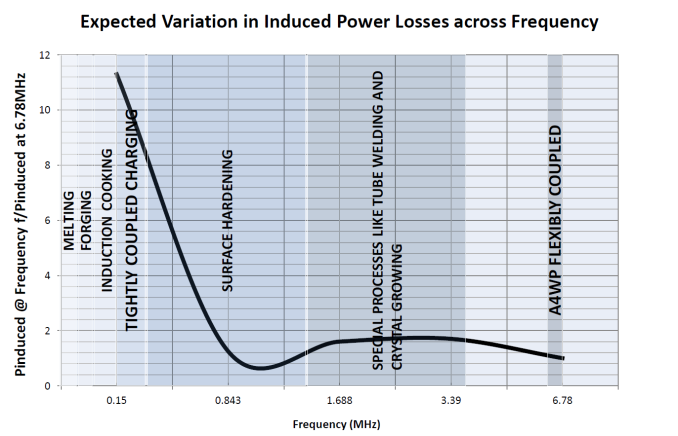The State of Wireless Charging Standards in Mobile
by Andrei Frumusanu on April 2, 2015 8:00 AM ESTRezence Resonance Charging
Earlier we saw the distinction between tightly coupled (TC) and loosely coupled (LC) induction charging systems. While A4WP’s Rezence system is called a magnetic resonance charging system, the basic principle is still based on magnetic induction. The critical difference between Qi and Powermat standards is that it is a Rezence is based on a loosely coupled coil system.
Inductive power frequencies and use-cases (Source)
A4WP systems work on a much higher frequency compared to tightly coupled systems such as defined by PMA and WPC. Rezence’s operating frequency is defined on a strict 6.78MHz (±15kHz) band compared to the 110-357kHz range that Qi and Powermat operate in.
Instead of a tight coil on the transmitter and receivers, we see the usage of a specifically shaped resonator designs. An A4WP transmitter has typically larger footprint than Qi or Powermat designs, with various classes of designs available depending on power requirement. Currently the widely adopted one is the Class 3 transmitter which has a size of 204x146mm and meant for smartphone device use-cases.


A4WP Class 3 spiral type 235-135 power transmit resonator (Source 1, Source 2)
The class system allows A4WP for a variety of size power transmitter unit (PTUs) and power receiving unit (PRUs) resonator coil systems depending on the number of devices and power you are targeting to charge. The class 3 PTU supports up to 16W transmit power.
| PTU Class | Maximum transmission in power |
Minimum PRU Support |
| Class 1 | TBD | >1 x Category 1 |
| Class 2 | 10W | 1 x Category 1, 2, or 3 |
| Class 3 | 16W | 2 x Category 1,2, or 3, or 1 x Category 4 |
| Class 4 | 22W | 3 x Category 1, 2, or 3, or 1 x Category 4 |
| Class 5 | TBD | TDB |
| PRU Category | Maximum reception out power |
Example Applcations |
| Category 1 | TBD | BT headset |
| Category 2 | 3.5W | Feature Phone |
| Category 3 | 6.5W | Smart Phone |
| Category 4 | TBD | Tablet |
| Category 5 | TBD | Laptop |
The current PRU categories are mainly defined for feature phone and smartphone devices with output powers of respectively 3.5 and 6.5W. We should be seeing class 3 devices as the most prevalent category implemented in smartphones in the near future. A class 3 PTU can charge at least two class 3 PRUs at full power, which should be sufficient for most use-cases.
A4WP WPT multi-device charging architecture (Source)
As mentioned before, the LC design of the Rezence charger allows for multiple receivers for a single transmitter, enabling a "star network" of PRUs for each PTU.
While Qi and Powermat respectively use either modulation on the power signal and RFID for communication between the transmitter ans receiver devices, Rezence work with a Bluetooth Low Energy (BLE) connection between all the different actors. There is no device pairing involved as communication is done over GATT (Generic Attribute Profile), a BLE feature.
At MWC2015 multiple vendors were demonstrating their A4WP implementations and chargers, and it was much more impressive to see them in action compared to the TC systems such as Qi and Powermat. Mediatek had a vertically standing Rezence charger which was demonstrated on a Galaxy S4 with custom backplate integrating Mediatek's tri-standard charging solution and powering the device via the dedicated power pins.
Practically, Rezence also seems to be the better solution as one doesn't have to deal with alignment of the device on the charging surface. Charging surfaces can vary in size and have an advantage of reduced complexity as it still remains a single resonator coil, where as Qi requires multiple overlapped coils to achieve the same effect and Powermat doesn't allow such flexibility in the first place.
Closing Thoughts
Having shed a bit more light on the difference and characteristics of the three main charging standard today, the question is on how the future of wireless charging will look. There is an undisputable battle of politics going on between the different standards associations, with each wanting to have their say and their own solutions to the wireless power transfer problem. Though right now the odd man out in all of this is the PMA, as it's hard to argue that Powermat brings any tangible advantages over Qi, not to mention it's a much less widespread standard.
Rezence from the A4WP on the other hand seems to be promising. The A4WP sees tightly coupled systems as first-generation technology that will in the future be replaced by loosely coupled charging implementations such as Rezence. I don't think the lesser charging efficiency will be something that people will mind as the practicality improvements clearly outweigh the disadvantages. The PMA-A4WP merger is seen as a technology swap as the A4WP gains access to a tightly coupled standard and the PMA gets access to a loosely coupled standard.
Meanwhile the WPC is working on its own resonance based loosely coupled system to compete with Rezence, but it's still in the development and we don't yet have much information on it.

MediaTek's tri-standard charging solution demonstration board
IC designers are going forward with tri-standard compatible solutions for wireless charging and that's what I envison will be the the aim for most device manufacturers who will want to include wireless charging into their products. This solves the device compatibility issue, but doesn't solve the problem completely as not all devices will be able to adopt it due to differing form factors. Rezence here again offers the best offering for form factor diversity, power transfer and charger interoperability. Though with the number of factions involved in this battle, it's not necessarily a given that this will be a battle won by technology as opposed to politics.
Ultimately the wireless charging ecosystem has changed a lot over the last few years, and things could again change drastically over the next few years, so nobody knows for sure in which direction the market will shift. We'll be sure to keep an eye on WPT in the future and cover any emerging news on the topic.












90 Comments
View All Comments
blanarahul - Thursday, April 2, 2015 - link
The problem is that data wireless signals don't add up to more than 2-3 watts. With wireless power that figure can go anywhere from 20-70Watts. That's a lot.Daniel Egger - Friday, April 3, 2015 - link
> It's a distance thing. If you're really really close to it, yes, it'll have a far more powerful effect than the earth's magnetic pull. The earth's magnetics are far more prevalent, though, because it's so massive.True but totally missing the point. A permanent magnet is something completely different than a wireless transmitter is what I was trying to say.
robl - Thursday, April 2, 2015 - link
I currently use wireless charging with my Nexus7. I had a 1st generation device, and either the usb port or the charging electronics became intermittent and died, probably through repeated connect/disconnects of the cable. Wireless charging on the 2nd generation device should work around it. I agree with the article, getting proper placement of the device is hard, but I got used to it and it's "there" 90% of the time. So a charging standard that is less efficient but allows for much easier placement will be a complete win for me. Yes, I wish I wouldn't be wasting power, but imagine this will continue to improve with future generations...sonicmerlin - Thursday, April 2, 2015 - link
You forgot to mention Witricity, which while a part of the Rezence standard, also offers "highly resonant" magnetic coupling that allows for charging over multiple feet rather than inches.Also timeline-wise they announced the WiT-5000C3 development kit in November last year so companies could start creating devices compliant with the Rezence standard. Intel has adopted the Rezence standard, so you'll be seeing wireless charging in laptops next year.
If you were wondering (like I was) why it's taken so long for Witricity (which demoed at TED in 2009) to come to market, there's a good engadget video explaining it (starting at 8:30): http://www.engadget.com/2014/11/07/witricity-ceo-e...
hobostu3000 - Thursday, April 2, 2015 - link
I use the Qi-Infinity portable wireless power bank to charge my phone on the go. It's nice not having to carry around a USB cable and a power bank. It can be tricky but I'm also able to place my phone and the charger in my front pocket in order to charge my phone while walking around. The power bank also has the option of charging via USB so I can always charge via cable in the front pocket option isn't available.alin - Thursday, April 2, 2015 - link
Please tell me how can you answer a phone and still charging it in the same time?What about answering the phone with it's battery almost dead and egaging in a conversation.
You still need a wall socket for the wireless adaptor.
And if you find it hard to plug in the usb cable in your phone, sorry, but, your smartphone is smarter than you :)
Houdani - Thursday, April 2, 2015 - link
The secret to wireless charging is to NOT wait until you have no charge left. That's the selling point. Don't wait until you absolutely need a charge. Just set it down when you're not otherwise using it and it'll stay topped off.Yes, you could also follow this practice with a USB cord, too. But the nuissance of futzing with a cord keeps folks from bothering.
Impulses - Thursday, April 2, 2015 - link
Exactly, after getting a couple wireless chargers I find I charge more often... Never liked using the phone plugged in anyway, cord either gets in the way or I feel like I'm about to damage the port.mkozakewich - Thursday, April 2, 2015 - link
You can use an external battery. Ideally, that battery could charge wirelessly.Dorek - Thursday, April 2, 2015 - link
"Please tell me how can you answer a phone and still charging it in the same time?"...the speakerphone?